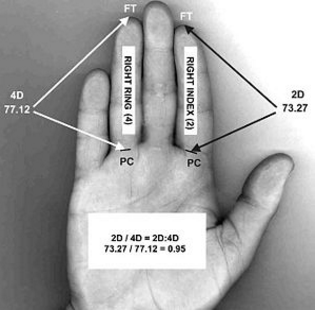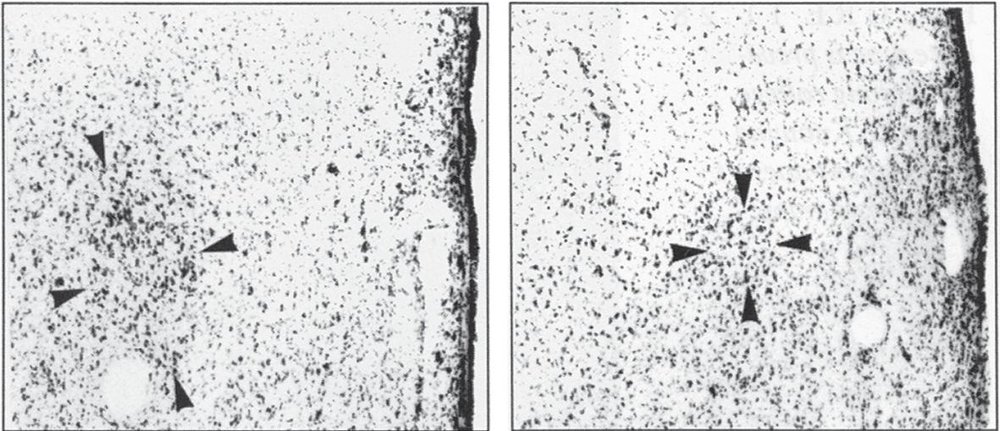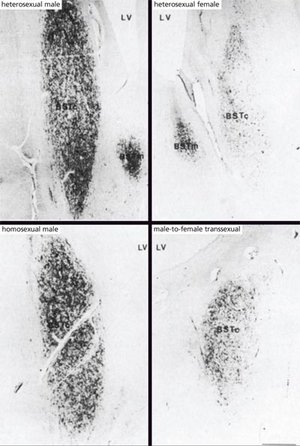Impact of brain development on sexual orientation and gender
Am I from birth? Did I choose the orientation myself? Regardless of what you can be told in the church, there is evidence (albeit very weak) that differences in the development of our brain can affect sexual orientation and sexual self-determination. Periodically, studies show that the activity, coherence and structure of certain parts of it in gays are significantly different from those of ordinary people, as well as in cisgenders and transgender people . But, as in many other areas of neurobiology, one cannot say 100% which way this dependence works: do these differences determine who you will be, or does your experience and behavior give these structures a similar shape? Many scientists believe that these differences can be traced from the very beginning, and that hormonal or genetic factors influence them. Let's see what we know today about how your brain (probably) tells you who to lead to your home.

A lot of things happen when you are in the womb. You have a head, arms, legs, eyes. You begin to feel pain ( not earlier than the 7th month). You are also exposed to hormones circulating in your blood. Among them are androgens (such as testosterone), which are believed to be involved in determining your sexuality. Intrauterine androgenic theory states that different levels of androgens in the womb influence the structure and functioning of the brain regions responsible for who we are drawn to. Simply put, she assumes that gay women have been exposed to too much testosterone, and gay men got very little or too much (but if everything really was that simple).
There are such proofs of this theory, perhaps unexpected for you - for example, the length of the fingers. It turns out that the amount of testosterone obtained in the womb is reflected in the length of our fingers - so that the ratio of the lengths of the index and ring fingers for men and women is different (for men of normal orientation the index finger is usually shorter than the ring finger, and for women of normal orientation their length coincides ). In various studies, it has been shown that in lesbians the length of the fingers is more often the male (shorter index finger), and in gay men the length of the index finger is either much less than the ring finger, or is equal to that . These findings are used to prove that an atypical amount of testosterone obtained before birth affects sexual orientation (but, of course, this theory is not 100% proven ).
')

But intrauterine hormones not only affect sexual preferences. There are heated debates whether gender identity is related to the effect of androgens on the brain of the embryo. Genitalia and the brain do not get sexual certainty at the same time - anatomical differences appear in the first three months of pregnancy, and the brain pulls up later . Due to different developmental schedules, it is possible that these processes go in different ways: you can get a vagina, and then, due to an atypical surge of testosterone, form the male brain.
So far, the findings are far from conclusive and confusing, and only one thing is clear: getting too large or small amounts of androgens before birth most likely affects your sexual preferences and gender identity through changes in the brain structure. So what are these differences in the brain?
Suppose that hormonal and genetic factors played a role and determined the development of the brain in the homosexual direction. Now what?
Studies show that many regions of gay brains, which usually differ between men and women, look atypical for their gender. It was found that certain regions of the hypothalamus - a region responsible for, among other things, reproductive behavior and sexual responses - are different in gays and ordinary people.
First, the INAH 3 region of heterosexual men is almost two times larger than gays (since the publication of the study, there has been only one successful repetition of it ). Secondly, the hypothalamus in gay men and heterosexual women reacts to the pheromones from male sweat, and the pheromones from female urine cause a reaction only in the odor center . The effect of the hypothalamus does not end there: in one study, it was found that in gay men it reacts to fluoxetine, a common antidepressant, not at all as much as in heterosexual men. For some reason, this study did not attach importance, although it can greatly affect clinical practice: if the serotonergic system (fluoxetine interacts with serotonin) in gays works differently, perhaps they should be treated differently for depression?

The big lump on the left is INH3 in heterosexual men, the smaller lump in the right is INH3 in homosexual men.
Another similarity in the brain between gay men and ordinary women is the system of connections in the amygdala, which is responsible for emotional centers. Their connections between the tonsil and the emotional regions were stronger. And lesbians are usually more like ordinary men, in which the amygdala is more strongly associated with the motor area of the cerebral cortex (responsible, among other things, for attention and reaction to what is happening, such as the " fight or flight " reaction). All this is very speculative, but these findings can be associated with stereotypes about the fact that gay men are more emotionally responsive.

Connections of the tonsils in ordinary men and women (HeM and HeW) and homosexual (HoM and HoW). You can see similar pictures in ordinary women and gay men, as well as in ordinary men and gay women.
More general differences were found: it was shown that the ratio of the size of the brain hemispheres in gays resembles the size of ordinary women (both hemispheres are approximately the same), and in lesbians the brain is asymmetric as normal men (right hemisphere is slightly larger). Also, gay and females have approximately the same number of connections between the two hemispheres (there are more than males) - this may be due to sexual differences related to recognition functions and language . Interestingly, other regions of the brain that are not related to gender and reproductive functions also differ.
Transgender people in the brain also have certain differences. Scientists have discovered that the structure of the brain called BNST (central subdivision of the bed nucleus of the stria terminalis), located in the hypothalamus, necessary for male sexual behavior, in men is twice as large in size and contains twice as many neurons than among women. It was also found that in M-F-transsexuals, the size of a BNST is comparable to that of a female (when testing one F-M-transgender, they found BNST with male characteristics - 1 , 2 , 3 ). These differences preceded hormone therapy and were not affected by sex hormones taken in adulthood. Apparently, BNST coincides with the gender to which the transgender feels, and not with what is indicated in his passport.
Moreover, it was found that there are far fewer androgenic receptors in the brain of MF-transsexuals than in cisgender men. Such a difference can lead to a reduced activity of the testosterone signaling system, which results in insufficient brain masculinity. In addition, an MRI study showed that the corpus callosum, the plexus of nerve fibers in the brain, connecting the right and left hemispheres, is also different in women and men, and reflects the perceived gender in transgender people, and not biological (just like the size of BNST) .

Top left - BNST heterosexual man, top right - women, bottom left - homosexual men, bottom right - transgender MF
It can be seen that sexuality and gender are very complex topics, and many factors influence who we like and how comfortable we are in our body. And I didn’t even touch upon other important aspects that play a role in this area - genetics ( 1 , 2 , 3 ), epigenetics ( 1 , 2 ), birth order , environmental influence ... Science has a long way to go before it can respond to the question of how these features are determined. From the point of view of the brain, we have some guidelines: apparently, fluctuations in the level of androgens in the womb play a role in determining whether the brain will develop in the direction of a homosexual or heterosexual person, and whether you will feel like a man or a woman. In any case, whoever you decide to bring home - a pretty girl, a nice guy (or both) - have fun and do not forget about protection!

Intrauterine development
A lot of things happen when you are in the womb. You have a head, arms, legs, eyes. You begin to feel pain ( not earlier than the 7th month). You are also exposed to hormones circulating in your blood. Among them are androgens (such as testosterone), which are believed to be involved in determining your sexuality. Intrauterine androgenic theory states that different levels of androgens in the womb influence the structure and functioning of the brain regions responsible for who we are drawn to. Simply put, she assumes that gay women have been exposed to too much testosterone, and gay men got very little or too much (but if everything really was that simple).
There are such proofs of this theory, perhaps unexpected for you - for example, the length of the fingers. It turns out that the amount of testosterone obtained in the womb is reflected in the length of our fingers - so that the ratio of the lengths of the index and ring fingers for men and women is different (for men of normal orientation the index finger is usually shorter than the ring finger, and for women of normal orientation their length coincides ). In various studies, it has been shown that in lesbians the length of the fingers is more often the male (shorter index finger), and in gay men the length of the index finger is either much less than the ring finger, or is equal to that . These findings are used to prove that an atypical amount of testosterone obtained before birth affects sexual orientation (but, of course, this theory is not 100% proven ).
')

But intrauterine hormones not only affect sexual preferences. There are heated debates whether gender identity is related to the effect of androgens on the brain of the embryo. Genitalia and the brain do not get sexual certainty at the same time - anatomical differences appear in the first three months of pregnancy, and the brain pulls up later . Due to different developmental schedules, it is possible that these processes go in different ways: you can get a vagina, and then, due to an atypical surge of testosterone, form the male brain.
So far, the findings are far from conclusive and confusing, and only one thing is clear: getting too large or small amounts of androgens before birth most likely affects your sexual preferences and gender identity through changes in the brain structure. So what are these differences in the brain?
Brain Differences
Suppose that hormonal and genetic factors played a role and determined the development of the brain in the homosexual direction. Now what?
Studies show that many regions of gay brains, which usually differ between men and women, look atypical for their gender. It was found that certain regions of the hypothalamus - a region responsible for, among other things, reproductive behavior and sexual responses - are different in gays and ordinary people.
First, the INAH 3 region of heterosexual men is almost two times larger than gays (since the publication of the study, there has been only one successful repetition of it ). Secondly, the hypothalamus in gay men and heterosexual women reacts to the pheromones from male sweat, and the pheromones from female urine cause a reaction only in the odor center . The effect of the hypothalamus does not end there: in one study, it was found that in gay men it reacts to fluoxetine, a common antidepressant, not at all as much as in heterosexual men. For some reason, this study did not attach importance, although it can greatly affect clinical practice: if the serotonergic system (fluoxetine interacts with serotonin) in gays works differently, perhaps they should be treated differently for depression?

The big lump on the left is INH3 in heterosexual men, the smaller lump in the right is INH3 in homosexual men.
Another similarity in the brain between gay men and ordinary women is the system of connections in the amygdala, which is responsible for emotional centers. Their connections between the tonsil and the emotional regions were stronger. And lesbians are usually more like ordinary men, in which the amygdala is more strongly associated with the motor area of the cerebral cortex (responsible, among other things, for attention and reaction to what is happening, such as the " fight or flight " reaction). All this is very speculative, but these findings can be associated with stereotypes about the fact that gay men are more emotionally responsive.

Connections of the tonsils in ordinary men and women (HeM and HeW) and homosexual (HoM and HoW). You can see similar pictures in ordinary women and gay men, as well as in ordinary men and gay women.
More general differences were found: it was shown that the ratio of the size of the brain hemispheres in gays resembles the size of ordinary women (both hemispheres are approximately the same), and in lesbians the brain is asymmetric as normal men (right hemisphere is slightly larger). Also, gay and females have approximately the same number of connections between the two hemispheres (there are more than males) - this may be due to sexual differences related to recognition functions and language . Interestingly, other regions of the brain that are not related to gender and reproductive functions also differ.
Transgender people in the brain also have certain differences. Scientists have discovered that the structure of the brain called BNST (central subdivision of the bed nucleus of the stria terminalis), located in the hypothalamus, necessary for male sexual behavior, in men is twice as large in size and contains twice as many neurons than among women. It was also found that in M-F-transsexuals, the size of a BNST is comparable to that of a female (when testing one F-M-transgender, they found BNST with male characteristics - 1 , 2 , 3 ). These differences preceded hormone therapy and were not affected by sex hormones taken in adulthood. Apparently, BNST coincides with the gender to which the transgender feels, and not with what is indicated in his passport.
Moreover, it was found that there are far fewer androgenic receptors in the brain of MF-transsexuals than in cisgender men. Such a difference can lead to a reduced activity of the testosterone signaling system, which results in insufficient brain masculinity. In addition, an MRI study showed that the corpus callosum, the plexus of nerve fibers in the brain, connecting the right and left hemispheres, is also different in women and men, and reflects the perceived gender in transgender people, and not biological (just like the size of BNST) .

Top left - BNST heterosexual man, top right - women, bottom left - homosexual men, bottom right - transgender MF
It can be seen that sexuality and gender are very complex topics, and many factors influence who we like and how comfortable we are in our body. And I didn’t even touch upon other important aspects that play a role in this area - genetics ( 1 , 2 , 3 ), epigenetics ( 1 , 2 ), birth order , environmental influence ... Science has a long way to go before it can respond to the question of how these features are determined. From the point of view of the brain, we have some guidelines: apparently, fluctuations in the level of androgens in the womb play a role in determining whether the brain will develop in the direction of a homosexual or heterosexual person, and whether you will feel like a man or a woman. In any case, whoever you decide to bring home - a pretty girl, a nice guy (or both) - have fun and do not forget about protection!
Source: https://habr.com/ru/post/370077/
All Articles